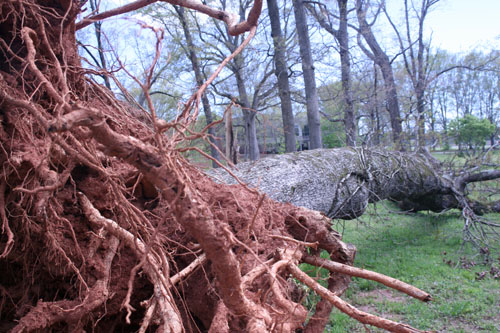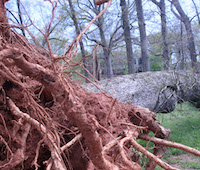Several powerful storms blew through Georgia in recent weeks and provided tree removal services and insurance companies plenty of work to do. Examining storm-damaged trees can provide many insights into why trees "fail" during windstorms.
Two of the most common forms of tree damage during windstorms are limb breakage and windthrow, or trees uprooted or broken by wind. Major limbs often fail when a heavy wind load, or the force on a structure due to the impact of wind, affects multi-stemmed trees or trees with narrow, vertical branches. Branches and stems that grow close together are structurally weaker than branches or stems that grow at wider, more horizontal angles. Over time, included bark becomes trapped between narrow, vertical branches and stems.
As the tree becomes larger, this bark acts as a wedge, forcing the branches further apart. Eventually, the right wind comes along and pushes the branches or stems just far enough apart to split the wood.
To help prevent this, University of Georgia Cooperative Extension recommends selecting only those trees that have one main stem and wide branch angles (45 degrees or wider) when adding new trees to your landscape. Correct any narrow, vertical branches and co-dominate stems with proper pruning and training while the trees are young.
Soft-wooded, fast growing trees, such as willow, silver maple, ‘Bradford’ pear and edible pear species, tend to have very weak, narrow branches that grow vertically. These species are generally considered short-lived since they have a tendency to self-destruct after about 20 years. They are also prone to wood rot and are often the trees that fail in windstorms. Avoid planting these types of trees close to your house or near high traffic areas.
Trees that blow over, roots and all, are typically those that have shallow root systems. For example, in the recent storms, many Leyland cypress trees were wind-thrown. Wind-throw is also common when high winds are accompanied or preceded by heavy rains. When the ground is saturated and the soil becomes soft, trees are easily uprooted.
Shallow root systems may be the result of compacted soils, frequent shallow watering, and limited soil volume adjacent to walls, foundations, driveways, sidewalks and parking lots. Trees can also be uprooted and/or blow over because of root damage due to soil excavation, the use of heavy equipment over the tree’s critical root zone, or trenching for utilities. Avoid planting trees in areas that have limited space for root growth and protect trees from construction damage.
Many large, older trees develop internal wood rot, compromising the structural stability of the tree. Wood rot in landscape trees is often the result of poor pruning practices, especially “topping” and other bad pruning cuts (such as leaving branch stubs) that create open wounds for extended periods. These open wounds allow water to penetrate the tree’s wood, which invites wood rot and wood-decaying fungi. By the time conks or mushrooms grow on the tree trunk or root flare, the tree is in advanced stages of decay and may be at risk of tree root or stem failure.
Infection and growth of the fungus in the wood take years to produce outward signs of conks and mushrooms. There is no cure for wood decay. When decay fungi are present, it’s only a matter of time before the strength of the tree’s stems or roots is compromised, causing the tree to break or fall. With recent rainfall amounts and saturated soils, keep a close eye on these types of trees for any shifting of the root plate and soil cracks that might indicate impending root failure for as long as these trees remain standing. Eventual tree removal is recommended.
If you have big, old trees on your property, consider consulting a certified arborist. If a tree is determined to be hazardous, a certified arborist will recommend removing or selectively pruning the tree to diminish the hazard. Locate a certified arborist online at www.isa-arbor.com.








